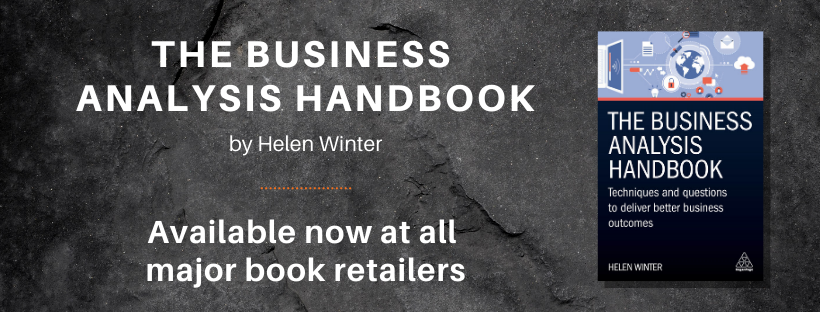
In a previous article A comprehensive guide to the major Business Analyst deliverables one of the first deliverables in a project or before a project is agreed is known as a business case. Other names that are used with similar content to a business case are Vision document or Feasibility study. The latter tends to have more detail in it.
This article is to provide the reason for this deliverable, what this needs to contain and some techniques.
The purpose of it is to:
- Set out and gain consensus of the direction of the project and scope from the senior stakeholders.
- Justify the benefits and estimated costs.
- It will provide enough evidence that the money is worth being spent, allow funding to be agreed or will show that it isn’t worth doing which then prevents further money being wasted.
- It makes sure that the overall solution is agreed and that it will meet the business needs.
The amount of time it takes to produce one should be proportional to the size, complexity and benefit of doing the work.
The contents will vary from company to company but the main subject areas in it will be the following:
- Executive summary
- Scope and objectives
- Problems / Opportunities
- Business Needs
- Solution Options
- Costs and Benefits
- Payback period
- Assumptions
- Timescales
- Risks
- Constraints
- Recommendations
Each of the headings above will now be explained in more detail:
Executive summary
Should be no more than a side of A4. Provides senior stakeholders with a brief overview and conclusion.
Scope and objectives
It is important that the sponsor sets out the Vision. The role of the sponsor is to have accountability for the change being proposed and ensuring the benefits are met. See the article a technique for identifying project scope for more detail. It is important to specifically state also what is out of scope.
Problems and opportunities
Once the scope is understood the problems and opportunities must then be identified. Below are the types of questions to ask of the sponsor and the stakeholders identified.
- What opportunities do you want the project to achieve?
- What problems do you want resolved?
- Who and what does it affect?
- What is the impact of not resolving these problems?
- What would a successful solution look like?
Business needs
There will be different types of need to be assessed and this will vary depending upon the size of a project. There may be different sections required by categories such as:
- Business area
- Processes
- People
- Inputs
- Outputs
- Solution approach
- Learning and development
Depending upon time allowed and desired detail; the business analyst may also be involved with:
- writing a business requirements document to feed into this section or
- be involved with documenting the processes to understand more about the needs or
- analysing any existing systems that fall into the scope of the business case
Solution Options
More than one option must be considered including the option of doing nothing. It is important to set out the costs and impact of this for comparison.
Costs and benefits
A major consideration for approving a change to go ahead and which option to pick is whether it is worth spending the money compared with the benefits of doing it. A cost benefit analysis is a method for doing this. The costs and benefits identified should be revisited throughout a project to ensure it is still worth doing.
Types of costs that need to be considered are:
- People
- Hardware
- Software
- Suppliers
- Consultancy
- Location
- Running costs / maintenance
- Costs of funding e.g. loans
- Contingency
On the benefits side, considerations are:
- Direct reduced costs from having the change implemented e.g. no longer having to pay out costs for hardware, software, people, processes etc.
- Indirect savings due to changes as a result of the solution being proposed.
- Costs avoided
- Intangible benefits that can’t be quantified. This can’t be included in the cost/benefit calculations but can still provide powerful reasons for continuing with the project e.g. reputation risk, improved staff morale, better customer experience etc.
Payback period
Once the costs and benefits are compiled the payback period can be calculated. The payback period is required to provide management with an understanding of how long it will take to get the money back. If the money spent on the project will be repaid back in 3 – 5 years then the appetite to proceed is more likely to be greater.
Assumptions
It is important to document each of the assumptions made when estimating the costs and benefits. That way there can be a judgment on how likely each assumption is likely to be correct and whether it can be verified so no longer an assumption. It will also show that if an assumption is proven to be incorrect that the costs / benefits will need to be revisited. It will also help in providing the level of confidence in the costs and benefits provided.
Timescales
The desired timescale may influence a decision of which option to recommend. There needs to be an evaluation of whether each solution can meet the timescales required.
Risks
There may be different risks for each option considered
Constraints
There may be constraints for each option considered.
It may not be necessary to use the same level of detail for the headings above for every option but they should provide the detail necessary to show why one recommendation is made over another.
Recommendations
There should be a recommendation after evaluation of the options. The recommendation may change based on the feedback received after being reviewed by various stakeholders. It is important to identify the decision makers and to be able to explain in this section reasons for the recommendation.
Thoughts? Questions? Please share in the comments.
If you have found this article useful then you might like my book – The Business Analysis Handbook – Techniques and Questions for better Business Outcomes. The book is available from www.koganpage.com and all major print and e-book retailers.


It’s rare to find such good information on blogs, so thank you for sharing; I was hunting for something similar and came across this one.
Hi Oliver,
Thanks for the feedback and glad you found it useful.
Regards,
Helen